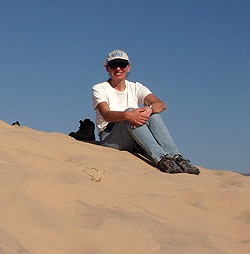Feature
Bringing Space Down to Earth
06.16.05
| Who Are NASA's Earth Explorers? The student thinking about El Niño. The scientist studying climate. And the farmer looking at satellite images. All of these people are Earth Explorers. They're all curious about how Earth works. This is a story about a NASA Earth Explorer. Nominate an Earth Explorer! Tell us about the Earth Explorers you know. We're looking for students, teachers, scientists and others who are working with NASA Earth science data and imagery to better understand our home planet. Send your nominations to Dan Stillman: dan_stillman@strategies.org. |
New tools help scientists learn more and more about space. The same tools can also help us learn more about Earth. That's where Diane Evans comes in. She works for NASA. She makes sure that tools used to study space are also used to study Earth.
Earth Explorers talked with Diane. We asked her to explain what she does. And we asked why she likes geology so much. We also asked what she would tell young girls who want to be scientists. Here's what she had to say.
Earth Explorers (EE): What does it mean to use space tools to study Earth?
Diane: Here's an example. We have tools that help us learn how stars form. And we have tools used to map Venus. These same tools can also be helpful on Earth. They can help us learn about ozone and earthquakes. The facts we learn can make us more healthy. And they might even save us money.
EE: What are some things that NASA scientists are working on?
Diane: We want to measure tiny amounts of gas in the air. And we want to see small changes in how much salt is in water. These are really hard things to do. But they could be a big help. They could help us figure out how much Earth will warm in years to come.
EE: Geology was your focus when you were in school. And it played a large role in the early part of your working life. What started you on this path?

|
| Image above: Diane Evans sits on a sand dune in the Mojave Desert. Credit: NASA |
EE: In school, you studied the geology of Mars. Now there's talk of humans going to Mars. Did you ever think this would be possible?
Diane: One of my jobs in school was to weigh Moon rocks. Back then we thought about the day when we'd have rocks from Mars to study as well. And yes, there was talk about the goal of humans going to Mars.
EE: What is the neatest place you've gone to while working for NASA?
Diane: I would have to say China. I was there in the early 1990s. We were in small towns. Cars were rare and people drove donkey carts. There were very few Americans. It was a joy to interact with the local people.
EE: What have you learned from working with scientists around the world?
Diane: It's important for scientists from all parts of the world to work together. I once worked on a project that involved three countries. The U.S., Germany and Italy all took part. We all had to cooperate with each other. I learned a lot about people from other places. I learned what matters to them. And I learned how they make decisions.
EE: What would you say to young girls who might want to go into science?
Diane: Science can be a good choice for women. You'll be respected for your work, not just who you are. But there are plenty of other jobs for girls, too. The main goal is to find something you like.
See previous Earth Explorers articles:
+ View site
Related Resources
The Space Place: Spinoffs Memory Game
+ View site